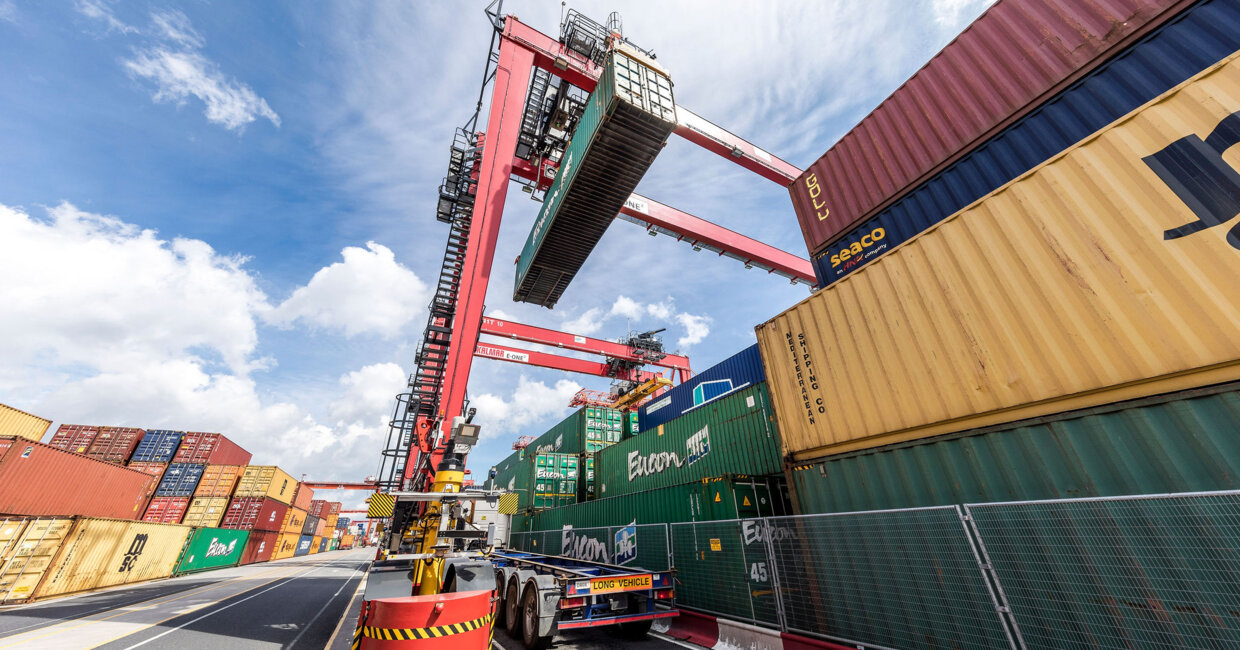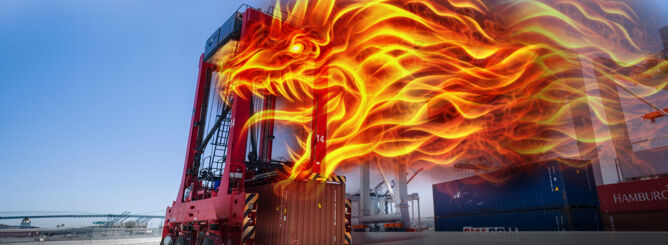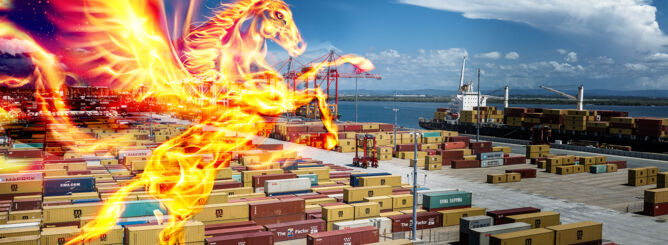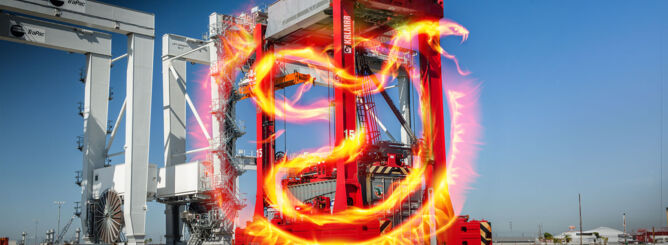Expert Q&A: Risks and rewards in terminal automation
Kalmar's Terminal Design Services team discusses the future of automated terminals and the deployment challenges that are holding terminals back from investing in automation.
Kalmar's top executives share their thoughts about automation, how Kalmar approaches the technology and how to overcome the challenges that the port industry faces in today’s climates. Answering the Q&A from the Terminal Design Services team at Kalmar Automation Solutions were Vice President Timo Alho, Senior Manager Jarno Kuipers and Manager Christopher Saavedra.
How has the port industry progressed with automation in recent years?
We have seen that automation has been slowly but steadily gaining more ground in container terminal operations. Automation of the stacking yard has become widely accepted for new container yards globally, and many terminals have deployed automated solutions for the horizontal transportation of containers. Remote control and semi-automation functions have also become more common for quay cranes.
The drivers of automation investments have become more diverse than earlier. Besides saving on operating costs, operators are looking to improve occupational safety at terminals, resolve issues with labour availability, provide better ergonomics to staff, and gain greater control over their operations.
However, despite so many recent successes, there is still a long way to go for automation to become the standard that all operators can and want to adopt in their operations.
There is clearly a lot of interest, but what is holding terminals back from investing in automation?
Automation requires significant upfront investments, and immediate financial pressures can make it difficult to realise the value of an automation deployment. The length of the remaining concession period can hold back terminal operators, if the benefits will not be seen before the concession expires. Therefore, investments require support from the port authority, enabling long enough concession periods and maybe even setting automation as a requirement for the concession.
Furthermore, automation investments also do present some risks, as previous projects have demonstrated. Implementing automation in an operational terminal is particularly complicated, so the potential disruption discourages operators unless they are forced to do it. In the end, terminals often turn to process automation solutions that can be implemented with fewer risks but still improve operational efficiency.
Lastly, automated terminals require new expertise in operating, troubleshooting and maintaining systems. Particularly given the steep learning curve of new technologies, the process to transform internal and external workforces to have the right skills might create an additional hurdle when making the decision in favour of automation. In the end, however, once a terminal automates and gains competitive advantage, it usually encourages other terminals in the region to do likewise.
You mentioned risks that are holding back the automation deployment. What is behind these risks?
There have been multiple factors. Sometimes the adoption of a completely new technology has been more difficult than originally expected, while sometimes the integration between the various IT systems from different vendors has been challenging.
The companies that adopt automation technologies often fail to oversee an organisation’s transformation, because they focus too much on the physical construction work. When the system goes live, the operational organization is not ready to cope with it, as the project delivery team might have been too disconnected from the operations team. Consequently, the project team is the only one that can keep the system running. This escalates when operations are carried out continuously in consecutive shifts with different people.
Additionally, the system might not align completely with the local processes and operating environment. New procedures are forced to roll out in fast-paced environments, causing unplanned system and procedure changes along with all the subsequent implementation struggles that come with them. As terminals are real nexuses of information, it is very likely that these changes also impact external parties like shipping lines and their agents.
The quality of the data can cause issues when the data is processed automatically without human intervention. An inaccurate piece of data that in manual operation was meaningless, suddenly may become the root cause of a serious productivity issue.
Many terminals have adopted a ‘mix-and-match’ principle in automating their operations by using the suppliers considered as ‘the best of breed‘ for each individual subsystem. Unfortunately, this compromises the usability of the system for the end user. Diagnosing and resolving faults in this kind of mixed environment is very complex, especially when multiple user interfaces need to be cross-checked, often requiring manual intervention. The exceptions will not be noticed before they escalate on a terminal level, and have a serious impact on productivity.
It is important to understand that automation systems should operate at least for as long as the lifetime of the equipment. Therefore, it is essential that software can be maintained and upgraded, as the environment around it changes. Very often this is not considered in the procurement phase, where the focus is just on the go-live, and later it comes as a surprise.
Can you elaborate more how to manage and mitigate these risks?
Many of the automation projects globally have been purpose-built and customised, and significant amounts of new functionality have been implemented, to either push the boundaries of automation or adopt the systems to suit unique processes. To comply with these requirements, suppliers take the additional risk of developing new functionality during delivery, instead of replicating existing functionality proven on other sites.
One way to overcome this is by focusing on proven solutions that already exist. In case further functionality is needed, it is important to identify this early and plan specific risk mitigation strategies. If possible, it may be a good approach to try to plan to go-live with a standard and proven solution and introduce new functionality in controlled steps afterwards.
What steps will be needed to increase automation adoption?
Future systems will be easier to deploy. With increasing interest from existing terminals, suppliers are developing systems to be implemented on the existing footprint of manual equipment, phase-by-phase, in a live and busy container terminal environment.
Terminal operators need to start seeing automation in a wider perspective. The focus on automation projects will shift from technology and implementation to management of change in the organisation throughout the process. In the future, operators are no longer trying to automate their existing processes, but instead it is accepted that automation will change existing processes, responsibilities and work descriptions. The whole concept of Operations-Engineering-IT will be redefined.
What big innovations will improve the adoption of automation?
The most important thing is to focus on the end user. The key to high productivity will not be better optimisation algorithms, but helping end users get the most out of the system. Simpler systems with more efficient processes will let operators focus and keep the terminal performing in various operational situations, and quickly take the right actions.
We also expect to see a different type of relationship between terminal operators and automation suppliers that will be better suited for automation projects. We are already seeing new and innovative procurement strategies in various terminal automation projects, which all share an emphasis on value creation and risk reduction. One example is the performance-based contracting model, where the supplier-buyer relationship changes from a transactional one to a business partnership.
Why does the relationship between supplier and operator need to change as we move forward with automation?
As the automation system becomes the core part of the terminal’s operations, it is necessary to rethink how it can be continuously improved. Here, operator and supplier share a goal – the operator wants high productivity and consistency, both of which need a skilled and adequately resourced team. The supplier wants a high-performing reference case and satisfied customers. To make this possible, the current model needs to evolve into a partnership, where both parties can excel in their area and reach the mutual goal.
A longer version of this article was originally published in the June 2020 edition of Port Technology International. Read more here.
About the authors
Timo Alho has worked at Cargotec for 20 years, first in automation R&D, where his key project was the development of the Kalmar AutoStrad™ solution. During the past eight years, he has held various positions in terminal automation, from product management to the head of the cranes business line. He has been involved in all Kalmar terminal automation projects.
Jarno Kuipers is a container terminal automation professional with more than 15 years’ experience in port automation. His background is in IT consultancy and in terminal operations management of a fully automated terminal, where he was involved heavily in the implementation of new technology. Before joining the Terminal Design Services team, Jarno held several positions involving sales and execution of terminal automation projects.
Christopher Saavedra is a container terminal automation professional with more than seven years’ experience in port management and operations. His background is in military naval sciences and in terminal operations management of conventional and automated terminals, where he was heavily involved in the implementation and testing of new technologies. In his previous position at Kalmar, he led process improvement and optimization, connecting processes with staff, IT, customs and customers.




